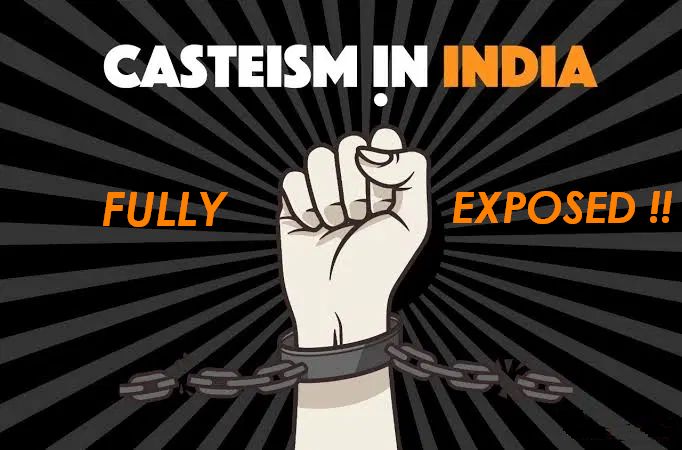Caste System Fully Exposed: Hidden Facts About Casteism In India


Emperor Shantanu married Satyavati, the daughter of a fisherman. His son became the king, so Bhishma did not marry, Bhishma vowed to remain childless for life.
Satyavati’s sons later became Kshatriyas, for whom Bhishma remained unmarried for life, would they have been exploited?
Ved Vyas, who wrote the Mahabharata, was also a fisherman, but became a Maharishi, he used to run the Gurukul.
Vidur, who is called as Maha Pandit, was the son of a maidservant, became the General Secretary of Hastinapur, Vidur Niti, written by him, is a great book on politics.
Bhima married the forest dweller Hidimba.
Shri Krishna was from the family of milk businessmen,
His brother Balaram used to do farming, always kept the plow with him.
Yadav has been Kshatriya, ruled over many provinces and Shri Krishna is revered by all, gave a book like Gita to the world.
Vanvasi Nishad used to study with Ram in Raj Gurukul.
His son Luv Kush studied in the Gurukul of Maharishi Valmiki who was a forest dweller and was the first dacoit.
So it is the matter of Vedic period, it is clear that no one exploited anyone, everyone had the right to education, anyone could reach the post according to his ability.
The characters were only on the basis of work, they could be changed to what is today called the Division of Labor in Economics.
Talking about ancient India, the Nanda dynasty ruled by Magadha, the largest district of India, was a barber by caste.
The Nanda dynasty was started by Mahapadmanand, who was a barber.
After that the Maurya dynasty ruled the whole country, starting with Chandragupta, who was from a peacock-rearing family and a Brahmin Chanakya made him the emperor of the whole country. The Mauryas ruled the country for 506 years.
Then came the rule of the Gupta dynasty, who ran horse stables and traded horses. The country was ruled by the Guptas for 140 years.
Except for the 36-year rule of Pushyamitra Shunga, 92% of the time in the country was ruled by those who are today called Dalits backward, so where did the exploitation come from?
There is nothing exploitative here either.
Then begins the time of Medieval India, which is from 1100 AD – 1750 AD, during which Muslim rule was mostly for most of the time.
Eventually the Marathas emerged, Baji Rao Peshwa, who was a Brahmin, made the Gaekwad, a cow herder, the king of Gujarat, the Holkar of the shepherd caste, the king of Malwa.
Ahilya Bai Holkar herself was a great devotee of Shiva.
She built many temples and Gurukuls.
Mira Bai who was a Rajput, her guru was a tanner Ravidas and Ravidas’s guru was Brahmin Ramanand.
There is no point of exploitation here.
Dirt started in the country from the Mughal period and from here things like purdah system, slave system, child marriage started. Widows used to end their life by jumping into burning pyre to avoid being sex slaves of the Mughals (Islamic terrorists) who killed their men in offensive attacks. Later this tragic act was isolated as sati-system by the British to show the world how evil practices were going on here which they corrected.
From 1800 AD-1947, there was British rule (which invaded as East India Company) and from here building of casteism narrative starts – which they did under the policy of divide and rule.
In the book “Cast of Mind” by British officer Nicholas Dark, you will find how the British started propaganda on casteism, untouchability and how selfish Indian leaders politicized it in their own interest.
In these thousands of years of history many foreigners came to the country who wrote books on the social condition of India, such as Megasthenes wrote Indica, Fahien, Hue Song and Alberuni among many others. No one wrote that anyone was exploited here.
Yogi Adityanath who is not a Brahmin, Mahant of Gorakhpur temple, Uma Bharti of backward caste has been Maha Mandleshwar. Birth based caste system was brought to weaken the Hindus.
It is clear from the above that varna is based on karmic tendencies and overall deeds – and not on birth. And yes, just like every person can chose to work in any layer or vertical of an organization, similarly any person based on capacity/interest/tendencies can chose to contribute at that layer in a society.
Ravana became an asura even though he was a Brahmin and Shabari became a Devi even though she was a dalit.
Your caste is determined only by your deeds, not by birth.
So be proud to be an Indian and save yourself and others from the conspiracy of hatred, malice and discrimination.
Jai Hind
DISCLAIMER: The author is solely responsible for the views expressed in this article. The author carries the responsibility for citing and/or licensing of images utilized within the text.
